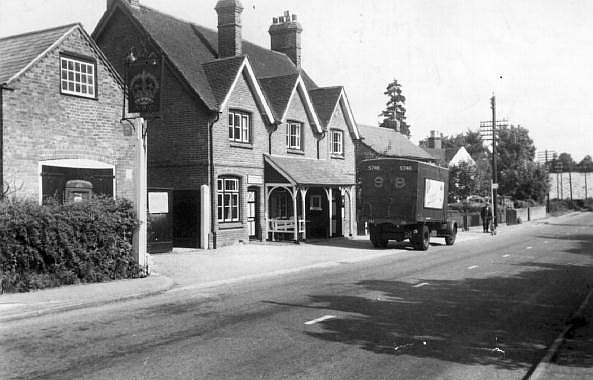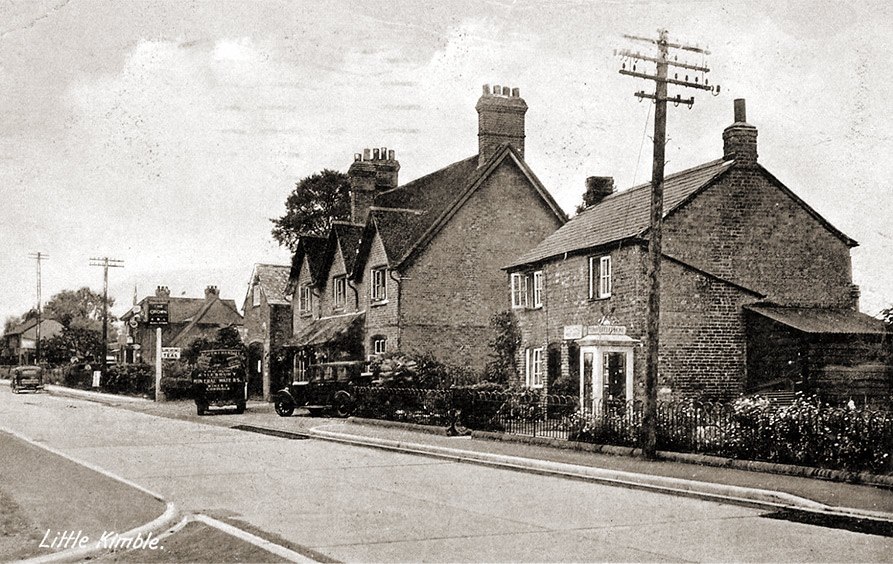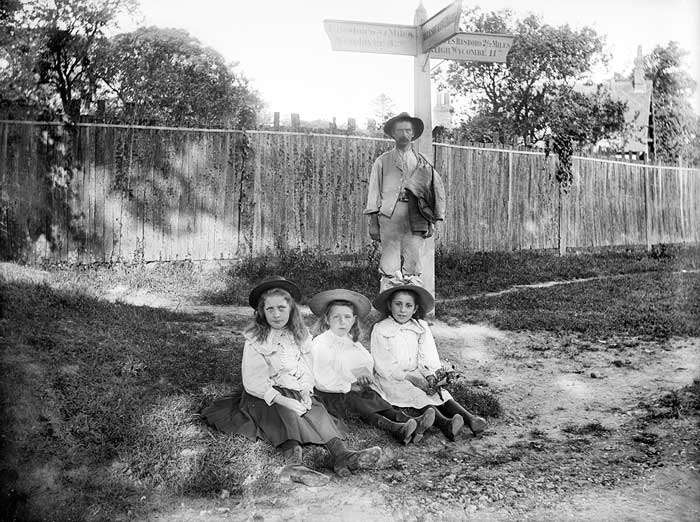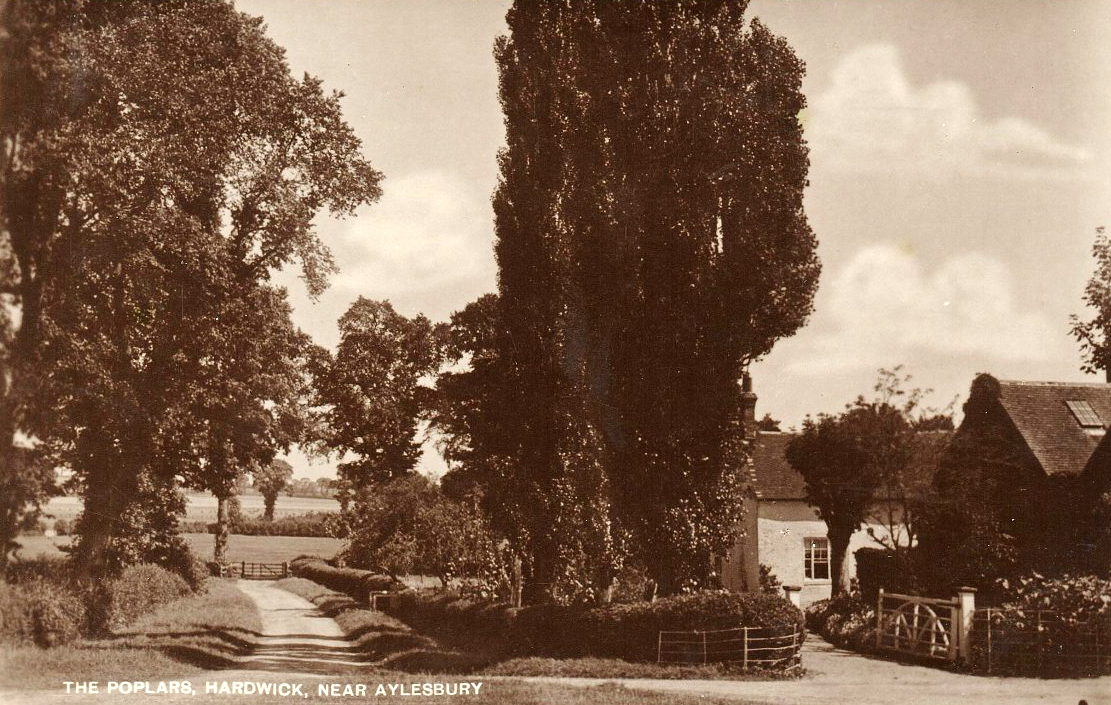Chenebelle (11thC); Parva Kynbelle (14thC); Little Kymbell (15thC).

The Division of Bucks now known as the Hundred of Aylesbury is formed by the Union of the 3-Ancient Hundreds of Elesberie (Aylesbury), Risberge, (Risborough) & Stane, (Stone), and still retains the formally the Appelation of the “Three Hundreds of Aylesbury.”

The Parish of Little Kimble lies on the Northwestern Face of the Chiltern Hills. The Hills are well Wooded. There is a small Lake in the Grounds of Ladymede House, out of which runs a Stream called Bonny Brook. It Flows to the North through Little Kimble Village to the Hamlet of Marsh.

Residents at this address. 1863/John Hailey/& shopkeeper/../../Duttons Dir
1869/J Hailey/../../../Kellys Dirctory
My Gt Grandfather Frederick James Chilton was born in 1853 , my Grandfather was born in 1881 – both Owned the Crown; & my Father was born there in 1922. Also the Buckingham Arms, Aylesbury , Bucks was owned late 1830-1867 by my Gt Gt Grandfather William – Tim Chilton


There is a Prehistoric Hillfort at the Summit of Pulpit Hill in Great Kimble. This is a fairly small Hillfort, covered in mixed & Beech Woodland, but surrounded by beautiful Woods & Valleys, with both an SSSI & the Prime Minister’s Country House in close proximity. Parking is available on the edge of the Road between Princes Risborough & Great Missenden, and a comfortable walk can take in both the Hillfort & also Whiteleaf Cross & it’s Associated Barrows, with a The Plough at Cadsden conveniently located at the Half-way point. The Fort is very obvious when reached, as the Ditches & Earthworks are very Pronounced, but not all that high & this coupled with the Trees can make the shape of the Fort hard to discern. The View is largely blocked by the Trees too, but where Gaps can be found it is worth a look, particularly at Sunset. The sides of the spur on which the Fort stands are extremely Steep on all but the South-eastern, where the Ground slopes steadily but gradually through the Wood, until the Woods end at the Road between Butler’s Cross & Gt Missenden, at the Main Entrance to Chequers. The South-Western, Western & Northern Slopes of the Hillfort are designated as a SSSI & Nature Reserve. This Hillfort – Pulpit Hill is one of the most evocative Iron Age Forts.


During the Roman Occupation of Britain, there was a Roman Villa at Little Kimble & a Tumulus near Great Kimble Church is probably a Burial Mound from the same Period. In Norman times a Motte & Bailey Castle was erected at Little Kimble and later developed into a Moated Site for a Medieval Dwelling house.


The height of the Land varies between 300-ft & 500-ft above the Ordnance Datum. The Subsoil in the Hills is Chalk & in the Lower Lands Upper Greensand. The Occupation of the people was entirely Agricultural; Arable & Pasture Farming is carried on, 234-acres being Arable Land & 311-acres of Permanent Grass. The Village lies on the Road from High Wycombe to Aylesbury, & there is a Railway Station to the South of the Village on the Great Western Railway. The Parish was Inclosed under an Act of Parliament for Inclosing the Common Fields of Great & Little Kimble & Ellesborough. The Award was given on 2nd May 1805. Little Kimble has now been Amalgamated with Great Kimble Parish, by a Local Government Order of 25th March 1885.

Scotsgrove Brook: – starts off in Little Kimble, flows past and through Ford before skirting Haddenham & joining the Kingsey Cuttle Brook. Both Haddenham & Stone Sewage Treatment Works discharge into this Brook, resulting in the potential of a very large Phosphate, Nitrate & Ammonia Load. Additionally, a lot of New Housing Estates being added to the Villages will increase the Sewage Flow considerably. However, Thames Water maintain that the STW is more than capable of dealing with the Loads placed on it.

Manors: In 1086 a sub-Tenant named Albert Held Little Kimble of Turstin son of Rolf. In the time of King Edward the Confessor one of his Thegns named Brictric Held the Manor of Little Kimble. After the Norman Conquest, however, it was Granted to Turstin son of Rolf, who Held it at the time of the Domesday Survey. For more than a Century the name of the Lord of the Manor is completely Lost, but presumably, in the 12thC, it was Held by James de Newmarket, who died before 1215, leaving 2-daughters & Heiresses, Isabel & Hawisia. Of these, Isabel was married to Ralph Russel, whose father, John Russel, had custody of her father’s Lands & Hawisia, 1st to John de Botreaux & 2nd to Nicholas de Moels. Both the Russels & the de Moels claimed the Overlordship of Little Kimble & it is impossible to disentangle their respective Shares of the Inheritance.

Very shortly after its Acquisition by the Russels & the de Moels, Humphrey le Dun appears as the Sub-tenant of a Knight’s Fee in Little Kimble. Half of this he Held in Demesne & half as a Mesne Lord. He paid Scutage, however, for the whole Fee in 1235. He died before 1246 & left an only daughter Margaret, who was a Minor in the King’s Wardship. In 1254 John le Waleys Held Little Kimble, having probably acquired it by marriage with the Heiress of Humphrey le Dun. John died between 1283 & 1289, leaving 4–Heiresses by his wife Margery & a son John by another wife. Little Kimble was divided among the daughters so that it seems certain that it was the Inheritance of their mother, who may thus be identified as the daughter of Humphrey le Dun. Of her daughters, Isabel married Simon de St Lys, (Adam de ?) married John de Middleton, Lucy married Adam de Kyngesham (or Kyngesmede) & the 4th daughter married John du Park. Adam de Kyngesham appears to have answered for the whole Manor in Matters of Feudal Incidence. His wife Lucy, after his death, probably married Walter de Shobintone, who also answered for the whole Fee in 1316. In 1346 the Tenants of the half-Fee that Humphrey le Dun & John le Waleys had Held in Demesne were Simon de St Lys, a Minor in the King’s Wardship, Richard du Park & John de Middleton, the Descendants of the 4–Heiresses of John le Waleys. Some years later, however, Nicholas Darches Claimed a 3rd of the Manor of Little Kimble from John atte Morhalle & John de St Lys, the latter being apparently the Heir of Simon de St Lys. The exact Claim of Nicholas is not given in the Pleadings, but he recovered Seisin of the Tenements in question. The History of the Sub-tenants of Little Kimble cannot be traced from this time, owing probably to the subdivision of Land among the Descendants of the co-Heiresses of John le Waleys.

Half a Knight’s Fee called Bulbecks Manor in Little Kimble was held by the Bolebec Family, under the Mesne Lords of the Whole-Fee. Herbert de Bolebec Granted Land in the Parish to the Abbey of Missenden in the 12thC & after his death his Widow Alice succeeded him as the Tenant of the ½-Fee. In a Charter, Gilbert is named as her Son & Heir, but in 1254 another Herbert Held the Land. At his death, which took place before 1266, he Held the Manor of Kimble & 1-Carucate of Land there, which passed to Gilbert his brother & Heir. The latter died before 1298, leaving a son named Henry. In 1346 John de Bolebec & his Tenants Held the Manor, and he also confirmed the Grants to Missenden made by his Ancestors.
On his death, Robert Russel, the son of the Ralph Russel already mentioned, was found to have Held the Overlordship of the Manor of Little Kimble, which was reckoned as 1-Fee, apart from Hardwick. In 1302/3 William, brother & Heir of Robert Russel, with John de Moels, Held the 3-Townships as 1-Fee, Little Kimble being Held in Demesne by a sub-Tenant, according to the Inquisition made for Cotteslow Hundred, but under the Hundred of Stone he appears to have been the Overlord of 1-Fee in Little Kimble alone. In 1346 Edmund Russel Held this Fee; he was the son of a Robert Russel & died. In 1708 the Sub-dean of Lincoln Presented. leaving no direct Heirs. The Descendants of his sister Sybil claimed some of his Lands in Notts, but neither they nor the Descendants of William Russel seem to have laid any Claim to Little Kimble. In 1486, however, a Manor in Little Kimble was said to be Held of the Heirs of Edmund Russel.
The Moels rarely claimed the whole of Little Kimble. In 1284-86 & 1302/3 Roger de Moels & John de Moels were Joint Overlords with the Russels. John de Moels died Seised before 1310 of half the Hamlet of Kimble; his grandson, however, another John, Held the Overlordship of 1-Knight’s Fee in Kimble at the time of his death. He left 2-daughters, the elder of whom Inherited Little Kimble in 1338.

She was the wife of Sir Thomas Courtenay & their daughter & Heiress Muriel married John Dinham. Shortly after this, the sub-Tenancy of part of Little Kimble appears to have Lapsed & thus the Dinhams, who succeeded the Moels became the Tenants in Demesne of their Manor. Sir John Dinham died in 1457/58 Seised of the Manors of Eythorpe, Crendwell & Little Kimble, Held of Edward, Prince of Wales, as of the Honour of Wallingford, by Right of Inheritance of Joan his wife, who survived him. His wife was the Heiress of the Darches Family, who had Held the 2–1st-named Manors & probably part of Little Kimble, as sub-Tenants but presumably, Sir John’s Right in the Manor came also through his great-grandmother, Muriel de Moels.
He was succeeded by his son John, Lord Dinham, who died leaving his 4-sisters & their children as his Heirs. In the Inquisition on his Lands, however, he was said to be Seised only of Tenements in Little Kimble, but his Heirs afterwards appear to have Held portions of the Manor. These Heirs were his sisters, Lady Elizabeth Fitzwarren, a Widow, who afterwards married Sir Thomas Brandon, & Lady Joan Zouche & his nephews, Sir Edmund Carew & Sir John Arundel, sons of his sisters Margaret & Katherine respectively. Elizabeth died Seised of a 4th part of the Manor in 1516, leaving John Bouchier as her Son & Heir. Lord Zouche & his wife Anne also Held a 4th part in 1531 & one of the co-Partners apparently Sold a Share to Sir William Compton. His grandson Henry, Lord Compton, conveyed this to Ralph Redman, William Hawtrey & Richard Hollyman, who very shortly afterwards acquired the Share of the Arundels as well.
During the 15thC, the Hampdens obtained Possession of the Manor. Edmund Hampden, the 2nd son of Edmund Hampden of Great Hampden, Forfeited his Lands to Edward IV, amongst them being a Messuage, 60-acres of Land, 6-acres of Wood & 8-acres of Meadow in Little Kimble, but the Manor was probably Held by the elder Branch of the Family & so was not Forfeited to the Yorkist King.
Thomas Hampden of Great Hampden died Seised of the Manor at the close of the 15thC. He was succeeded by his son & grandson, both named John; the latter left 2-daughters & Little Kimble passed to Barbara the 2nd. She married 1st, Edmund Smith, by whom she had a daughter Anne, the wife of William Paulet. Philippa, the Widow of the 2nd, John Hampden, married, as her 2nd husband, Sir Thomas Smyth & in 1554 they Quit-claimed the Manor of Little Kimble to William Paulet & his wife. Elizabeth Paulet, their only daughter & Heiress, married Oliver St John. The Manor was Sold by St John in 1609 to Robert Waller, who again Sold it to Edward Serjeant for £1,850. The Manor changed hands again in 1626 when Richard Serjeant is said to have Sold it, under the name of ‘Bulbecks Manor‘ to Richard Brasey of Thame. The latter in his Will Proved in 1647, left the yearly revenue from Lands & Wood & Tenements in Little Kimble to his wife for her life. After her death, they were to pass to Richard Croke, the son of Anne, the daughter of the Testator, for Life, and to Descend to his Children.
Nothing more is known of the Manor, but at the Close of the 17thC, it was apparently Held by the Family of Gibson. In 1692 there was a Lawsuit between Thomas Gibson Sr & Others v Richard Croke concerning Rights of Free Warren in Little Kimble. It was asserted on this occasion that Croke was Lord of the Manor and that it had belonged to his father before him. The Manor here referred to is probably Bulbecks (qv), but the Suit would seem to show that the Gibsons already had some interest in the Parish & in 1696 Thomas Gibson Sr, & his wife Mary & Thomas Gibson Jr & his wife Frances, appear in a Deed concerning Tenements in Little Kimble & a Court-Leet & View of Frankpledge to be Held within the Manor of Little Kimble. Thomas Gibson Jr apparently left no Male Heirs & the Manor passed to Mary & Elizabeth Gibson, who Held it in 1739. Elizabeth apparently married Thomas Hill & Held a Moiety of the Manor in 1767 & Mary married Robert Smith. They Held the Manor Jointly in 1771, but after their death, their Property was Divided. In 1817 a Moiety of the Manor was Held by Sir James Fellowes & his wife Elizabeth in her Right.
Richard Croke & his son, another Richard, both Held the Manor, which Descended on the death of the latter to his daughter Charlotte. She married William Ledwell & they Held the Manor of Little Kimble in 1758. The Property passed on his death to his Heir-at-Law, – Ledwell of Cowley. In 1792 William Bridges Ledwell, his son, Held the Manor & Sold it to Scrope Bernard, afterwards Sir Scrope Bernard Morland, Bart. The Manor was presumably bought at the same time as Great Kimble by Sir George Russell, Bart & is now in the hands of the Trustees of Henry Frankland-Russell-Astley, a Minor.
In 1254 John le Waleys & Herbert de Bolebec Held the View of Frankpledge in their Manors. In 1617 James I Granted to Edward Brudenell the Right to Hold a View of Frankpledge twice a year in Stoke Mandeville, Ellesborough, & Little Kimble, but in the 18thC, a Court Leet & View were Claimed by the Gibsons.

Great Western Railway
The Railway between Risborough & Aylesbury was a Branch of the Wycombe Railway to Oxford via Risborough & was originally Built on Broad Gauge, which is why the Trackbed is so Wide. It was completed in 1863 & Little Kimble was the Only Station on the Line. In 1867 the GWR took over the Line & it became the 1st Complete Line to be entirely converted from Broad Gauge to Standard Gauge in 1868 as a Test for the Conversion of the whole GWR Network.

Hardwick with Weedon – Hardwick Manor – A Fee of Wynebald de Ballon & Henry de Newmarch. Wynebald de Ballon Donated a part of Hardwick to Bermondsey Priory. (Weedon is North of Aylesbury & Hardwick is South of Weedon)
